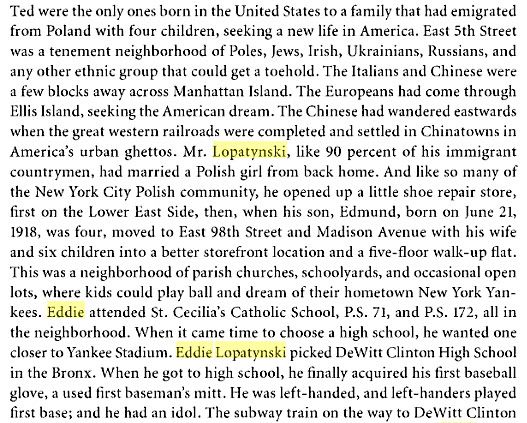an excerpt from the baseball biography project
Eddie Lopat, by Zita Carno
Eddie Lopat, "The Junkman," teamed with fireballers Vic Raschi and Allie Reynolds to form the Big Three starting pitchers on the New York Yankees' five straight World Championship clubs from 1949 through 1953.
He was born Edmund Walter Lopatynski on June 21, 1918, the first of seven children. The family lived on the Lower East Side of Manhattan in New York City, later moving uptown to be closer to the shoe-repair shop owned and operated by father John.
Lopat went to DeWitt Clinton High School. The school did not have a baseball team, so he played with outside teams. His usual position was first base. From an early age he had been a Yankee fan, having grown up with the Bombers of 1927 and beyond, and quite often he and some schoolmates played hooky to go to a ball game. He dreamed of playing for the Yankees one day.
While working summers as an usher at Radio City Music Hall, he attended a tryout held by the New York Giants. He was told he wouldn't do; he couldn't make the throw to second base. He went to a Dodger tryout, and they signed him to a minor league contract in 1936. The first thing he did was shorten his name to Lopat so it would fit better into a box score, the way Cornelius McGillicuddy had become Connie Mack.
The scout who used the phrase "good field, no hit" might have been describing Eddie Lopat. After two false starts he was with Greensburg in the Penn State League, but his .229 batting average got him packed off to Jeanerette, Louisiana, in the Evangeline League.
Warming up with a catcher before a game, he put a little something on the ball. His manager, Carlos Moore, noticed this and told him to throw a curve. Lopat did. Moore told him that with the right coaching he would become one of the best pitchers in the league.
Exit the first baseman, enter the lefthanded pitcher. In his first mound appearance, in relief, he allowed just two hits in 6 2/3 innings.
Still, he bounced around the minors for seven years: from Jeanerette to Kilgore, to Shreveport, to Longview, back to Shreveport. In 1939 he started experimenting with a screwball, which would later become his best pitch. And in 1940 he found love; he married Mary Elizabeth Howell, known as Libby. When he was ready to pack it in and return to New York, she persuaded him to give it one more year.







No comments:
Post a Comment